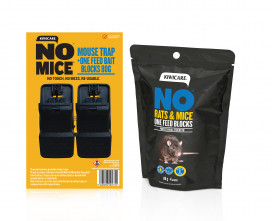Rats and mice: Understanding the rodent control options available to you

Have rats and mice got you at your wit's end? When dealing with a rodent infestation, finding the right method for pest control is essential. The two most common approaches to tackling the problem are traps and baits (aka rodenticides). But which method should you use, and where? In this blog, we'll explore the differences between rodent traps and rodent baits and discuss why you might choose one over the other, or even to use both at the same time.
Understanding rodent traps:
Rodent traps are mechanical devices designed to capture and kill rodents. There are two main types of traps available in New Zealand – Snap traps and Live traps. Rodent snap traps tend to be more humane as rodents are dealt with quickly and don’t suffer for prolonged periods of time. Live rodent traps are also great but leave you with the problem of what to do with the live rat or mouse once you’ve caught it (releasing it elsewhere doesn’t solve the problem of a rodent infestation) and they need to be checked daily within 12 hours of sunrise by law. You may also have heard about glue traps, but it's important to note that these types of traps are no longer allowed in New Zealand due to regulation changes. When using traps, it is important to understand what type of rodent you are dealing with. A mouse trap used on rats may not be strong enough to kill them quickly and can cause unnecessary suffering, while using a rat trap on mice may not work as mice may not be heavy enough to trigger the traps as needed.
The benefits of using traps
- Non-Toxic:
Traps are non-toxic and pose minimal risk to non-target animals and the environment when used correctly.
- Safe for Indoor Use:
Traps are generally safe for indoor use, making them suitable for homes, businesses, and other indoor environments where chemical treatments may not be desired like kitchens or daycares.
- Targeted Control:
Traps provide precise control by capturing individual rodents, ensuring you always know where they end up which makes cleanup and disposal a breeze. With baits, rodents can perish in hard-to-reach spots, complicating retrieval and clean up. In addition, traps make it easy to monitor the number of rodents being eliminated, offering a clear gauge of the problem's magnitude.
- Immediate Results:
Traps provide immediate results by quickly capturing and eliminating rodents upon activation, reducing the risk of prolonged infestations.
Understanding Rodent Baits (aka Rodenticides):
Rodent baits are anti-coagulant chemical products designed to attract and kill rodents when ingested. Baits are typically available in various formats, including pellets, blocks, and bait tracking powder. Baits come in two main formulations, one type of bait kills a rodent after a single feed and the other type kills a rodent more slowly after multiple feeds. Legally, rodenticides/baits must be used within bait stations and according to the instructions on the product label. A bait station refers to a rigid, reusable apparatus or container engineered or adjusted to securely hold baits, allowing easy access for target pests while minimizing the risk of spillage and preventing unintended access by non-target species. They also help to protect baits from environmental factors and prolong their effectiveness. Places like closed, secured, dry roof voids are ideal for bait station placement, or the use of a Dual Action Bait & Powder. Bait stations can also be safely placed outdoors, in barns/sheds and in crevices like behind fridges etc.
The benefits of using rat and mouse baits/rodenticides
- Broad Coverage:
Baits can provide broad coverage by targeting multiple rodents over a larger area, making them suitable for outdoor use in agricultural fields, gardens, and other expansive environments.
- Convenience:
Baits offer a convenient solution for rodent control, requiring minimal effort to deploy and maintain compared to traps
- Long-Lasting:
Baits can provide long-lasting control of rodent populations by continuously attracting and eliminating rodents over an extended period.
- Versatility:
Baits can be used in various settings, including both indoor and outdoor environments, making them a versatile option for rodent control in different situations.
Choosing the Right Method:
Both rodent traps and rodent baits are effective tools for controlling rodent populations, but they each have unique advantages and considerations. By understanding the differences between traps and baits and considering factors such as location, safety and the scale of the problem, you can choose the right method for your specific pest control needs.
Things to consider when choosing baits or traps
Location: Both traps and baits are ideal for indoor and outdoor use when used correctly. Although baits may be more suitable for outdoor environments where extensive coverage is needed.
Scale of the problem: If you’re dealing with a significant infestation or need to get on top of a problem quickly then baits are great, because multiple rodents can be targeted at the same time. Better still use a mix of both baits and traps to help hedge your bets. Rodents are clever and if they learn baits are dangerous, your traps will still be effective at controlling them and visa versa.
Now you have a better idea of the differences between baits and traps, hopefully you are set to make an informed decision on what’s right for you. Our website also offers detailed information on all of the bait and trapping products we offer, and our friendly customer service team are available to answer any other questions you may have on how to keep your property rodent free (and protect our native birds).
DIY Rodent Control Programmes & Advice
Now that you understand the benefits of each option have a read of the below guides. They provide tips and advice on what you need to do to resolve the problem and how to get the best results from your traps and baits.


